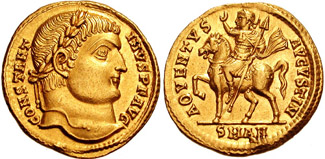11.3: Constantine
- Page ID
- 17053
Constantine did away with the system of co-emperors (although it would re-emerge after his death), but otherwise he left things as they had been under Diocletian's reforms. The eastern and western halves of the Empire still had separate administrations and he kept up the size and organization of the army. He also took a decisive step toward stabilizing the economy by issuing new currency based on a fixed gold standard. The new coin, the solidus, was to be the standard international currency of the western world for 800 years.

Constantine’s greatest historical impact, however, was in the realm of religion. He was the first Christian emperor, something that had an enormous effect on the history of Europe and, ultimately, the world. Before his climactic battle in 312 CE to defeat his last rival to the imperial throne, Constantine had a vision that he claimed was sent by the Christian God, promising him victory if he converted to Christianity. There are plenty of theories about a more cynical explanation for his conversion (most revolving around the fact that Constantine went on to plunder the temples of the old Roman gods), but regardless of the fact that he used his conversion to help himself to the wealth of "pagan" temples, he actively supported Christian institutions and empowered Christian officials. Ultimately, his sponsorship of Christianity saw it expand dramatically in his lifetime.
In 324 CE, Constantine founded a new capital city for the entire empire at the site of the ancient Greek town of Byzantium, at the intersection of Europe and Anatolia (he renamed it “Constantine’s City,” Constantinople, which is today Istanbul). It was at the juncture of the eastern and western halves of the Empire, with all trade routes between Asia and Europe passing through its area of influence. It became the heart of wealth and power in the Empire and a Christian “new beginning" for Roman civilization itself. The city grew to become one of the great cities of late antiquity and the Middle Ages; it was fed by grain from Egypt and brought in an enormous wealth through trade. Subsequent emperors also built up massive fortifications, walls so strong that it took 1,000 years for an enemy to be able to breach them (namely the Ottoman Turks, who finally conquered the city in 1453 CE).


